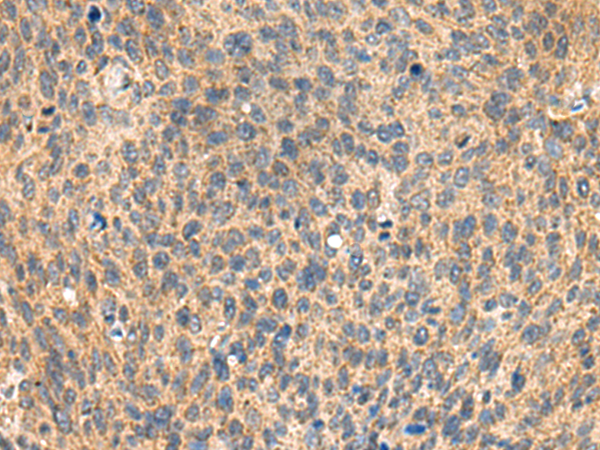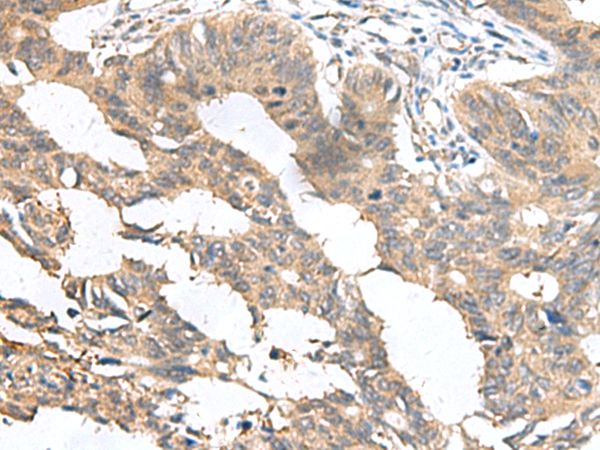

| WB | 咨询技术 | Human,Mouse,Rat |
| IF | 咨询技术 | Human,Mouse,Rat |
| IHC | 1/100-1/300 | Human,Mouse,Rat |
| ICC | 技术咨询 | Human,Mouse,Rat |
| FCM | 咨询技术 | Human,Mouse,Rat |
| Elisa | 1/5000-1/10000 | Human,Mouse,Rat |
| Aliases | CD-RAP |
| Host/Isotype | Rabbit IgG |
| Antibody Type | Primary antibody |
| Storage | Store at 4°C short term. Aliquot and store at -20°C long term. Avoid freeze/thaw cycles. |
| Species Reactivity | Human, Mouse, Rat |
| Immunogen | Fusion protein of human MIA |
| Formulation | Purified antibody in PBS with 0.05% sodium azide and 50% glycerol. |
+ +
以下是关于MIA(Melanoma Inhibitory Activity)抗体的3篇代表性文献摘要:
---
1. **文献名称**:*Melanoma inhibitory activity (MIA), a serological biomarker of malignant melanoma*
**作者**:Bosserhoff AK, et al.
**摘要**:该研究首次鉴定了MIA蛋白作为黑色素瘤特异性分泌蛋白,并开发了基于MIA抗体的ELISA检测方法,证实其在血清中的水平与黑色素瘤进展呈正相关,为临床诊断和疗效监测提供了重要工具。
---
2. **文献名称**:*Development of monoclonal antibodies against melanoma inhibitory activity (MIA) for immunohistochemical detection in tumor tissues*
**作者**:Guba M, et al.
**摘要**:研究团队制备了针对MIA蛋白的单克隆抗体,通过免疫组化验证了其在黑色素瘤组织中的高表达,同时发现MIA抗体可区分良性痣与恶性肿瘤,提示其在病理诊断中的潜在应用价值。
---
3. **文献名称**:*Targeting MIA protein reduces metastasis in melanoma through modulation of integrin signaling*
**作者**:Stoll SW, et al.
**摘要**:本文利用MIA中和抗体阻断MIA蛋白功能,发现其可抑制黑色素瘤细胞的迁移和侵袭能力。机制研究表明,MIA抗体通过调节整合素信号通路降低肿瘤转移风险,为靶向治疗提供了实验依据。
---
以上文献覆盖了MIA抗体的诊断开发、病理检测应用及治疗机制探索,反映了其在黑色素瘤研究中的多领域价值。如需具体文献来源(期刊、年份等),建议通过PubMed或Web of Science检索作者及关键词获取全文信息。
Melanoma inhibitory activity (MIA) antibody is a tool used to detect MIA, a small secreted protein (12 kDa) initially identified in the 1990s for its role in inhibiting melanoma cell proliferation and metastasis. MIA is primarily expressed in malignant melanoma and chondrocytes, playing a dual role in tumor progression. It promotes cancer cell invasion and migration by modulating extracellular matrix interactions and integrin signaling, while also exhibiting context-dependent anti-proliferative effects. Structurally, MIA belongs to the SH3 domain-containing protein family and is transcriptionally regulated by factors like MITF in melanoma.
Elevated MIA levels in serum correlate with advanced melanoma stages and poor prognosis, making it a biomarker for monitoring metastasis and treatment response. Beyond melanoma, MIA overexpression is observed in chondrosarcoma, glioblastoma, and breast cancer. Antibodies against MIA are used in ELISA, immunohistochemistry, and Western blotting for research and diagnostic purposes. Recent studies explore MIA as a therapeutic target, with neutralizing antibodies investigated for blocking tumor-stroma interactions. However, its pleiotropic functions in cartilage development and neurodegeneration necessitate cautious therapeutic exploitation. MIA antibodies thus remain pivotal in unraveling its complex biology and clinical applications.
×